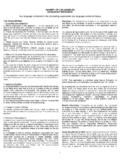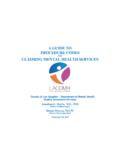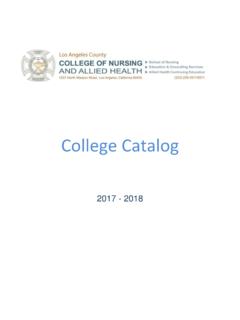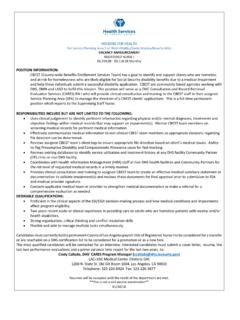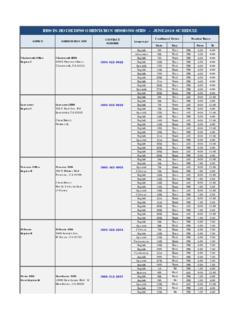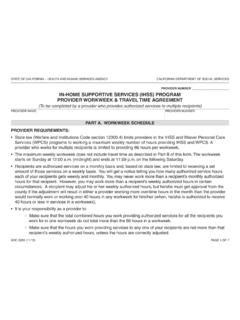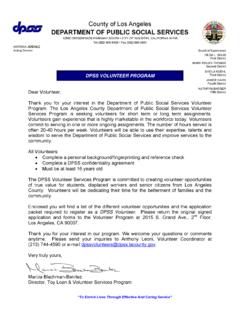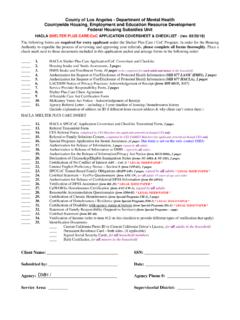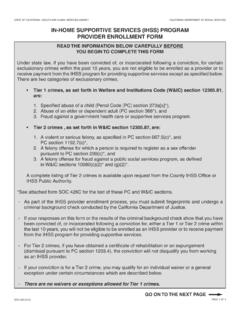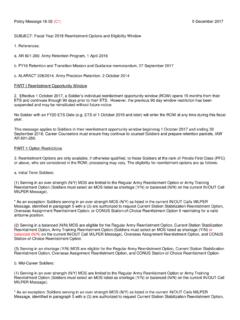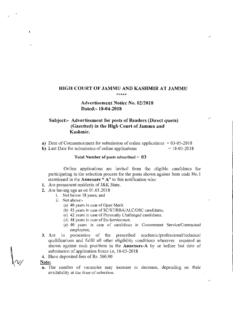Transcription of DEPARTMENT OF HEALTH SERVICES COUNTY OF LOS …
1 DEPARTMENT OF HEALTH SERVICES COUNTY OF LOS ANGELES (EMT, PARAMEDIC, MICN) subject : STROKE PATIENT DESTINATION REFERENCE NO. 521 EFFECTIVE: 04-01-09 PAGE 1 OF 4 REVISED: 12-01-18 SUPERSEDES: 07-01-18 APPROVED: _____ _____ Director, EMS Agency Medical Director, EMS Agency PURPOSE: To provide guidelines for transporting suspected stroke patients to the most accessible facility appropriate to their needs. AUTHORITY: HEALTH & Safety Code, Division , Section 1798 DEFINITIONS: Primary Stroke Center (PSC): A 9-1-1 receiving hospital that has met the standards of a Center for Medicaid & Medicare SERVICES (CMS) approved accreditation body as a Primary Stroke Center and has been approved as a Stroke Center by the Los Angeles (LA) COUNTY Emergency Medical SERVICES (EMS) Agency. Comprehensive Stroke Center (CSC): A 9-1-1 receiving hospital that has met the standards of a CMS approved accreditation body as a Comprehensive or Thrombectomy Capable Stroke Center and has been approved as a Comprehensive Stroke Center by the LA COUNTY EMS Agency.
2 CSCs have subspecialty neurology and neurointerventional physicians available 24 hours a day and 7 days a week who can perform clot-removing procedures ( , thrombectomy). Last Known Well Time: The time (military time) at which the patient was last known to be without the signs and symptoms of the current stroke or at his or her prior baseline. Local Neurological Signs: Signs and symptoms that may indicate a dysfunction in the nervous system such as a stroke or mass lesion. These signs include: speech and language disturbances, altered level of consciousness, unilateral weakness, unilateral numbness, new onset seizures, dizziness, and visual disturbances. Modified Los Angeles Prehospital Stroke Screen (mLAPSS): A screening tool utilized by prehospital care providers to assist in identifying patients who may be having a stroke. Los Angeles Motor Score (LAMS): A scoring tool utilized by prehospital care providers to determine the severity of stroke on patients who meet mLAPSS criteria.
3 A large vessel involvement is suspected if the total LAMS score from the three categories is 4 or greater. PRINCIPLES: 1. Patients experiencing a stroke should be transported to the most accessible facility appropriate to their needs. This determination will be made by the base hospital physician or Mobile Intensive Care Nurse after consideration of the guidelines established in this policy. Final authority for patient destination rests with the base hospital. 2. Basic Life Support units shall call an Advanced Life Support unit for suspected stroke patients. subject : STROKE PATIENT DESTINATION REFERENCE NO. 521 PAGE 2 OF 4 3. In all cases, the HEALTH and well-being of the patient is the overriding consideration in determining patient destination. Factors to be considered include: severity and stability of the patient s condition; anticipation of transport time; available transport resources; and request by the patient, family, guardian, or physician.
4 4. Service area rules and/or considerations do not apply to suspected stroke patients. 5. Patients with a history of previous stroke with new or worsening deficits should be routed to the Stroke Center according to this policy. POLICY: I. Responsibility of the Provider Agency A. Perform mLAPSS on all patients exhibiting local neurological signs. The mLAPSS is positive if all of the following criteria are met: 1. No history of seizures or epilepsy 2. Age 40 years or older 3. At baseline, patient is not wheelchair bound or bedridden 4. Blood glucose between 60 and 400 mg/dL 5. Obvious asymmetry-unilateral weakness with any of the following motor exams: a. Facial Smile/Grimace b. Grip c. Arm Strength B. If mLAPSS is positive, calculate LAMS (score from 0-5) from the mLAPSS motor items: 1. Facial droop Total Possible Score = 1 a. Absent = 0 b. Present = 1 2. Arm drift Total Possible Score = 2 a.
5 Absent = 0 b. Drifts down = 1 c. Falls rapidly = 2 3. Grip strength Total Possible Score = 2 a. Normal = 0 b. Weak grip = 1 c. No grip = 2 C. Transport the patient to the most appropriate stroke center in accordance with base hospital direction or section III of this policy. subject : STROKE PATIENT DESTINATION REFERENCE NO. 521 PAGE 3 OF 4 D. Document the results of mLAPSS, LAMS, and last known well date and time in the designated areas on the Patient Care Record. E. In order to ensure that proper consent for treatment can be obtained by hospital personnel, if possible, document the name and contact information of the family member, caregiver, or witness who can help verify the patient s last known well time in the Comments area of the Patient Care Record. When practical, transport the witness with the patient. II. Responsibility of the Base Hospital A. Provide medical direction and destination for all patients who meet mLAPSS criteria or have symptoms strongly suggestive of a stroke.
6 B. Determine patient destination based on stroke center status via the ReddiNet system and section IV of this policy. C. Notify the receiving stroke center if the base hospital is not the patient s destination. D. Document the results of mLAPSS, LAMS, and last known well date and time in the designated areas on the Base Hospital Form. E. Prompt prehospital care personnel to obtain and document witness contact information on the Patient Care Record. III. Destination of Stroke Patients All patients who have a positive mLAPSS and LKWT within 24 hours shall be transported to a LA COUNTY EMS Agency designated stroke center as follows: A. Transport to the closest stroke center: Patients with suspected acute onset stroke symptoms and a LAMS of 3 or less. B. Transport to the CSC: Patients with suspected acute onset stroke symptoms and a LAMS of 4 or greater, if transport time is less than 30 minutes. If transport time to the CSC is greater than 30 minutes, the patient shall be transported to the most accessible PSC.
7 C. Destination for patients with a positive mLAPSS whose LKWT is greater than 24 hours will be determined by the base hospital. D. If there are no stroke centers (PSC or CSC) that are accessible by transport within the maximum allowable time of 30 minutes, the patient shall be transported to the most accessible receiving facility. E. Ground transport is the preferred method of transport. Considerations for dispatching air ambulance transport shall include, but not limited to, the following: subject : STROKE PATIENT DESTINATION REFERENCE NO. 521 PAGE 4 OF 4 1. Geographic isolation of incident location ( , Antelope Valley, Malibu, Gorman, Catalina Island) 2. Immediate availability of air ambulance 3. Accessibility of a fully licensed and permitted helipad at the stroke center 4. Transport capability from helipad to the emergency DEPARTMENT of the stroke center CROSS REFERENCES: Prehospital Care Manual: Ref. No. 322, Stroke Receiving Center Standards Ref.
8 No. 501, Hospital Directory Ref. No. 502, Patient Destination Ref. No. 503, Guidelines for Hospitals Requesting Diversion of ALS Units Ref. No. 1200, Treatment Protocols Ref. No. 1251, Stroke/Acute Neurological Deficits
